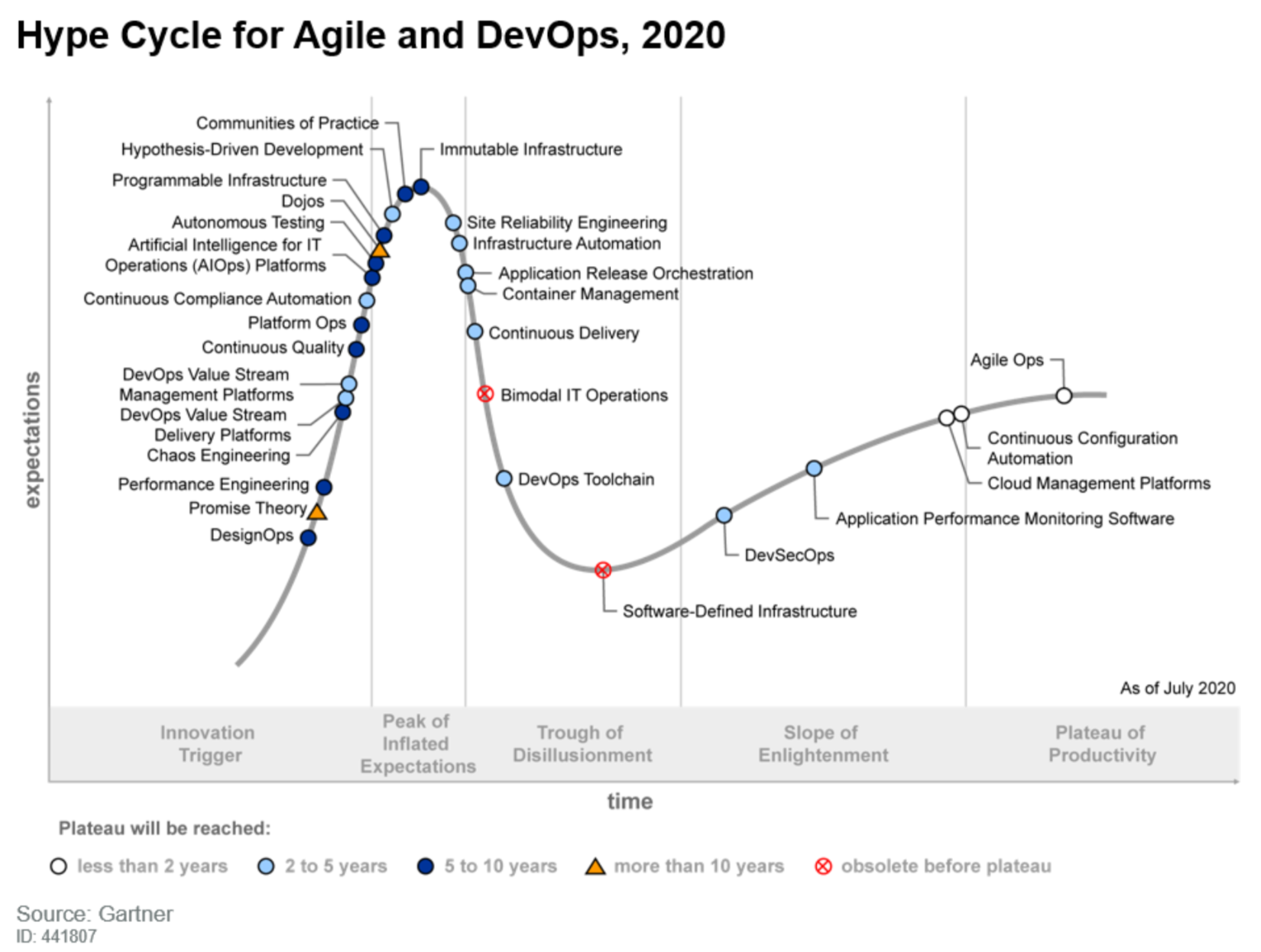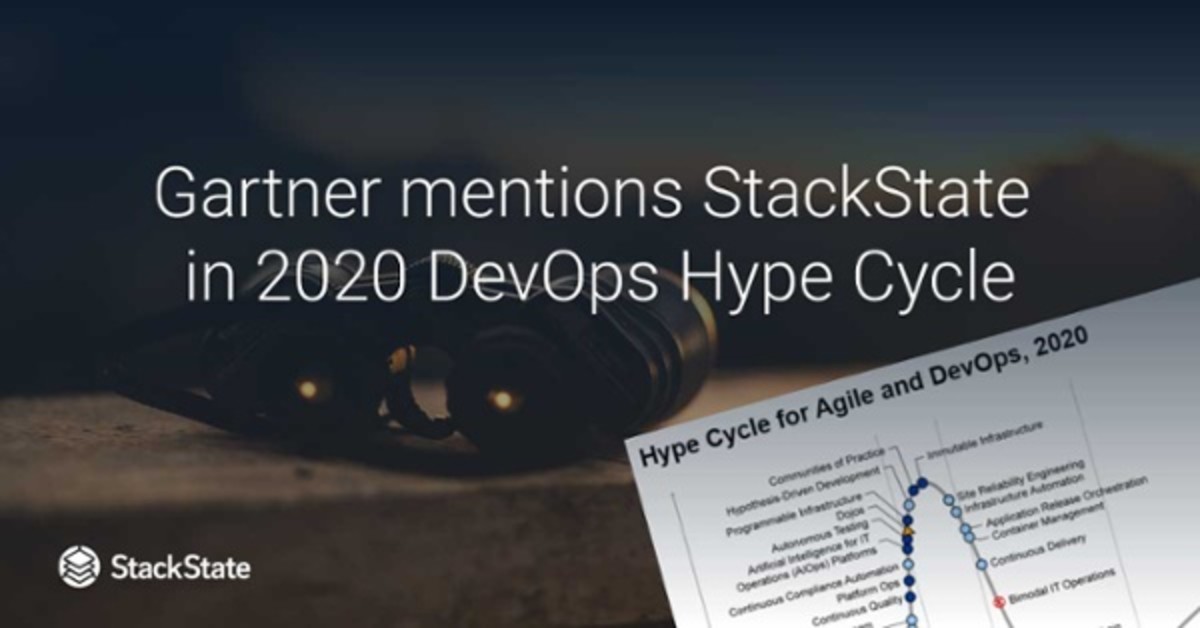Gartner's Hype Cycle for DevOps
The DevOps Hype Cycle includes critical approaches and technologies used to adopt DevOps within a company. According to Gartner, DevOps continues to grow. Only 8% of companies say they do not have any plans to adopt DevOps in 2019. In 2016 this was still 28%. New DevOps technologies are introduced on an increasingly frequent basis. The DevOps movement now consists of a plethora of technologies.
In this blog post, we focus only on the DevOps category in which StackState is mentioned as a critical vendor: Artificial Intelligence for IT Operations (AIOps) platforms. Different stages within the Hype CycleEach technology, like AIOps, goes through five key lifecycle phases during its lifetime. Gartner's Hype Cycle drills down into every one of them. In short, these are the five key phases:
Innovation Trigger: often no usable product or proven commercial viability but early proof-of-concept stories and media publicity;
Peak of Inflated Expectations: Early publicity produces several success stories—often accompanied by scores of failures. Some companies take action; most don't;
Trough of Disillusionment: Interest wanes as experiments and implementations fail to deliver. Producers of the technology shake out or fail;
Slope of Enlightenment: More instances of how the technology can benefit the enterprise start to crystallize and become more widely understood;
Plateau of Productivity: Mainstream adoption starts to take off. If the technology has more than a niche market, then it will continue to grow.
Want more like this? Gartner recommends to read their Market Guide for AIOps as well!
Time to the maximum value
Before we go into the current phase of the life cycle in which AIOps & StackState resides, it's also good to mention the Priority Matrix. It maps the time to maturity of technologies and frameworks in an easy-to-read grid format. It answers two high-priority questions:
How much value will an organization receive from an innovation?
When will the innovation be mature enough to provide this value?
In terms of value, Gartner distinguishes four levels in which organizations can benefit, ranging from low to transformational. Gartner identifies four different periods ranging from less than two to more than ten years in terms of years to mainstream adoption. If a technology falls into one of these periods, it gives you somewhat of an indication of how long it will take before it can provide its maximum value. However, that doesn't mean that it can be beneficial to start early even when full maturity of technology can still take some time.
Current status within the DevOps Hype Cycle
So by now, you should be entirely up to speed with Gartner's Hype Cycle. Time to dive into the current status of AIOps and StackState in Gartner's Hype Cycle.
Gartner defines AIOps as platforms that "combine big data and machine learning through support of all primary IT operations function through the scalable ingestion and analysis of the ever-increasing volume, variety, and velocity of data generated by IT operations. The platform enables the concurrent use of multiple data sources, data collection methods, and analytical and presentation technologies."
According to Gartner, AIOps technology is now at the peak of the Hype Cycle, meaning that there are now some success stories of the technology available (which you can read right here) and that some companies already have taken action in adopting the strategy.

Gartner expects that the complete process of adoption and maturity of the technology will take around 5-10 years and that interest and investment in the technology will continue to rise due to:
Rapid growth in data volumes;
Increasing data variety and velocity;
Challenges in maintaining observability and improving engagement due to the adoption of cloud-native and ephemeral architectures;
The need to intelligently and adaptively drive the automation of recurring tasks and predict change success and SLA failure.
Business Impact & value
According to Gartner, AIOps will deliver transformational value to businesses. Gartner defines transformational as a value that "enables new ways of doing business across industries that will result in major shifts in industry dynamics." Because it's the highest possible value rating, it's safe to say that products making use of AIOps are worthwhile and will have a substantial business impact. It will enable infrastructure and operations teams to enhance and transform primary operational functions with a real, automated insight generation capability, Gartner writes.
Gartner continues that because of AIOps, organizations across all verticals will stand to realize:
Agility and productivity gains — via active combined analysis of IT and business data, yield new insights on user interaction, business activity, and supporting IT system behavior;
Service improvement and cost reduction — via a significant reduction in the time and effort required to identify the root cause of availability and performance issues. Behavior-prediction-informed forecasting can support resource optimization efforts;
Risk mitigation — via dynamic analysis of monitoring, configuration, and service desk data identifying anomalies from both operations and security perspectives;
Competitive differentiation/disruption — via superior responsiveness to market and end-user demand based on machine-based analysis of shifts, beyond those that are immediately obvious to human interpretation.
Our vision on Gartner's DevOps Hype Cycle
In conclusion, it's good to see that the whole DevOps technology category is still growing. Organizations make a wise decision if they decide to implement DevOps technologies because they have lots of value to offer. Zooming in on AIOps within the DevOps category, Gartner states that it is now at the peak of inflated expectations and will reach maximum transformational value for businesses in 5 to 10 years.
At StackState, we don't see AIOps as an end-goal, but more as a means to an end. StackState offers a Topology-Powered Observability platform, making use of AIOps, which lets you manage your dynamic IT environment more effectively by unifying performance data from your existing monitoring tools into a single pane of glass. Enabling you to:
Decrease MTTR: Decrease MTTR by 80% by identifying root cause and alerting the right teams with the right information.
Less Outages: Reduce the number of outages by 65% through real-time unified observability and more planful planning.
Faster Releases: Increase application releases by 3X by giving time back to developers.
In contrast to AIOps, Topology-Powered Observability platforms leveraging AI like StackState can offer this value today. Take the next step and read this white paper to learn how your IT infrastructure can improve with three simple steps.



